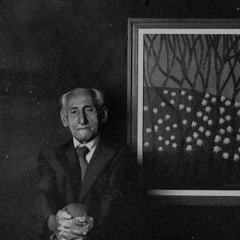A bilingual work that brings together the main works of the Minas Gerais painter Amadeo Luciano Lorenzato. Lorenzato produced a body of work estimated to be between 3,000 and 5,000 paintings with the most diverse themes and iconographies, reflecting his biography and his relationship with the landscape of Belo Horizonte, its surroundings, and its urbanization. His known works date from the 1940s when he returned to Brazil after spending nearly thirty years in Europe, until 1995, the year of his death. Unique in their techniques and styles, his paintings harken back to his working-class origins, a condition that led him to combine artistic ambitions with the need to support himself and his family through construction work. He could only fully dedicate himself to art after the age of fifty when he retired due to a work accident.
His profession as a painter-decorator inspired him to create an original pictorial technique, using adapted tools from wall decoration. With the help of a comb, he scraped the paint on the surface repeatedly, creating a fusion of colors with textures and promoting a sensation of movement. He often manipulated the paints from mineral pigments found on the market and frequently applied them over a layer of white lead that contributed to intensifying the vibrancy of the colors. The making of pictorial supports, an important part of his economy of means, led him to reuse pieces of wood panels and packaging, sometimes covered with fabric or paper, sewn or hand-glued. The formats were almost always small or medium-sized - at most, one meter on the longer side - denoting a certain sense of domesticity.
His paintings have a rough appearance: they are opaque, tactile, and sensory. For many years limited to a small circle of admirers, especially artists and art dealers in his hometown, Lorenzato's work has been gaining new audiences in the past twenty years through exhibitions, especially in commercial galleries, culminating in a series of international presentations in 2019. This reappreciation has solidified his place among Brazilian modern artists, contributing to the expansion of the canon. Like other artists derogatorily called primitive or naive, Lorenzato turned to popular sources, reprocessing them with erudite references within a non-hierarchical perspective. His work, therefore, should be understood as part of late Brazilian modernity. However, despite this renewed commercial interest, the art system has not been able to produce reflection on his work at the same pace through institutional exhibitions and academic studies.

